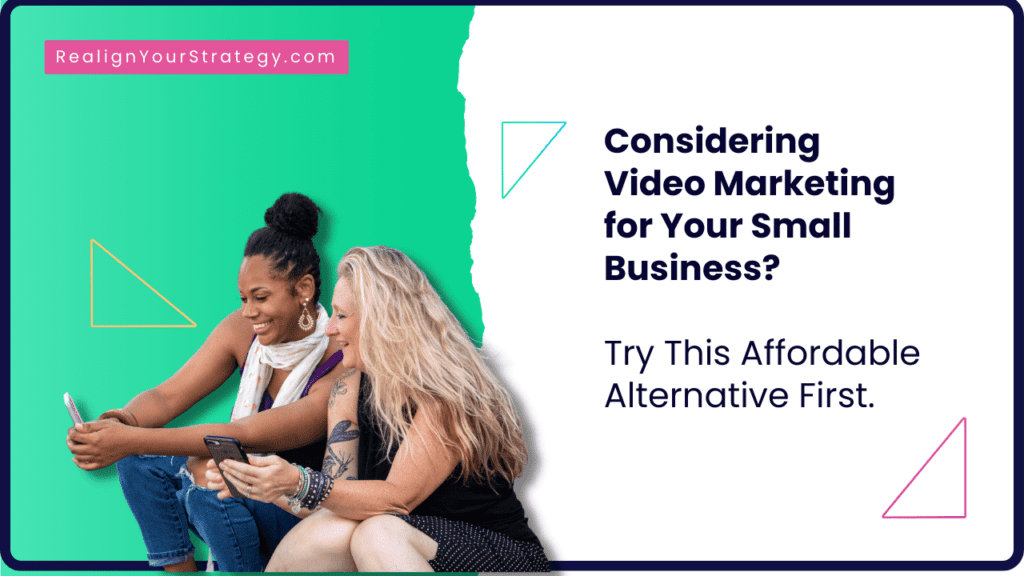It’s a rare small business owner who hasn’t been told to try video marketing for her company.
And according to Hubspot’s 2022 study, video seems to be more popular than ever with customers and marketers alike.
But for a local business with limited resources, adding video to your DIY digital marketing strategy can be an intimidating task. It requires new skills, new technology, and the space to do it right to get the most bang for your buck.
Is video marketing really worth it for small businesses?
The answer is, it depends.
Yes, there are several benefits of video marketing for small businesses. Even one or two videos have the potential to generate leads and increase sales for your company.
But before jumping in, there are a few things to consider to get the best return on your investment.
- What is the purpose of your videos? Do they provide actual value to your customers?
- What is the strategy for getting the right audience to view them and bring in traffic?
- Do you have the resources (time, money, and skills) to create quality content?
Videos only work if they are engaging, high value, and, most importantly, watched.
How can you provide value through video?
- If you are a trades business that works in people’s homes, build trust with your audience with a video explaining how your work makes homes safer.
- If you have created a unique product, generate interest and demonstrate the benefits with a video showing how that product can be used.
- If you provide a service that requires people to come to your office, give people the momentum they need to take action with a video showing them what they can expect when they get there.
Remember accessibility when using video marketing for your small business.
Even high-value videos can fall short when portions of your audience cannot access them. The majority of viewers watch videos with the sound off, for a variety of reasons. And some viewers simply cannot see the video well, but they are still interested in the content.
Custom captions, simple designs, and transcripts can help your videos reach a wider portion of your audience.
Video marketing works best when it is part of a greater strategy.
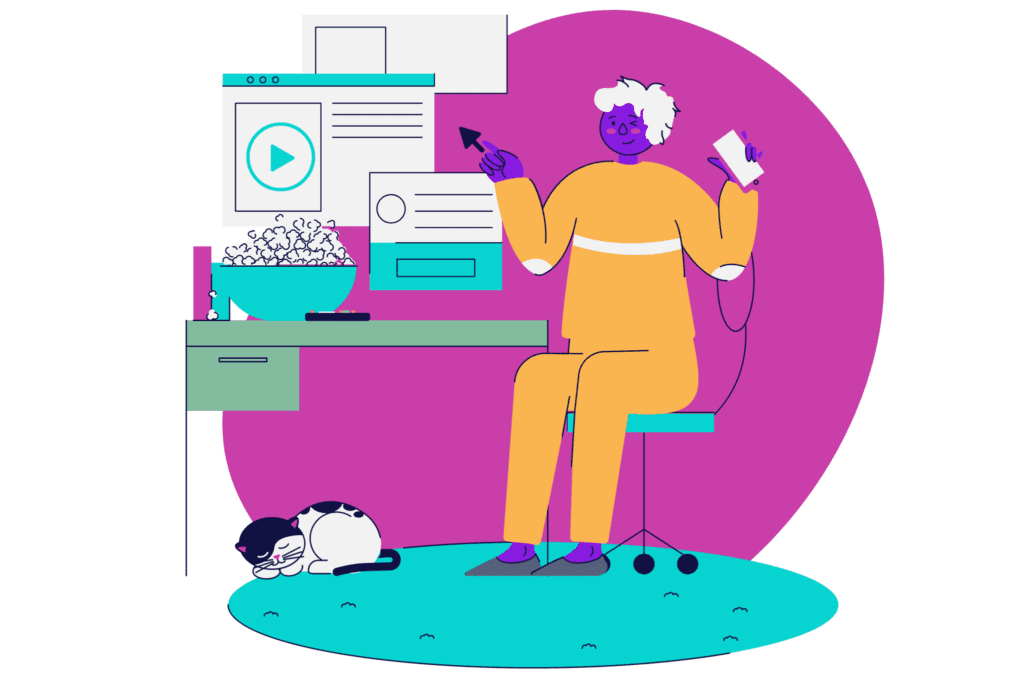
Video content can be an excellent resource for local businesses. But it won’t make or break your company’s success if you cannot commit the resources right now.
We typically recommend that our clients adopt a copy-first marketing strategy—in which video can play a part.
Why?
Because words show up everywhere our customers do. And the benefits of video marketing for small businesses are only enhanced by a focus on quality copy.
And if they’re written well, our words play a vital role in engaging, attracting, and retaining those customers, no matter the medium.
When it comes to ROI, focusing on copy first just makes the most sense.
A copy-first strategy is the most affordably effective way to market over the long term for most small and micro businesses.
Quality video marketing requires resources that smaller brands may want to wait to invest in right now.
Meanwhile, AI tools like Chat GPT* are making copywriting even easier. Now, a decent copywriter can pair with an AI to generate engaging content for business faster than ever before.
*A NOTE ABOUT USING AI for WRITING:
Text-to-text AI tools (like ChatGPT, Jasper, Bard, etc.) are a long way from replacing good copywriters. But used correctly, AI can make an excellent writing assistant—especially for someone trained in copywriting, marketing, and writing in your brand voice.
In the CTA and Writing Copy sections below, I’ll go into more detail about how small and mid-sized businesses can use AI.
But for now, I would like to issue a word of caution:
ChatGPT and other text-to-text AIs are notorious for making things up (also called “AI hallucinations”). The creators of ChatGPT explain why this phenomenon happens on their FAQ page. We’ve experienced it ourselves with ChatGPT and other AI tools.
Our remote team often uses video to communicate (and avoid unnecessary meetings). While brainstorming for this article, a team member recorded a video and noticed some inaccuracies in the AI-generated summary, as shown in the following image.
With careful use, AI can still be extremely helpful for generating copy and content quickly and helping experienced writers be even better. But staying relevant, engaging, and building trust with your audience should never be entrusted to AI alone.
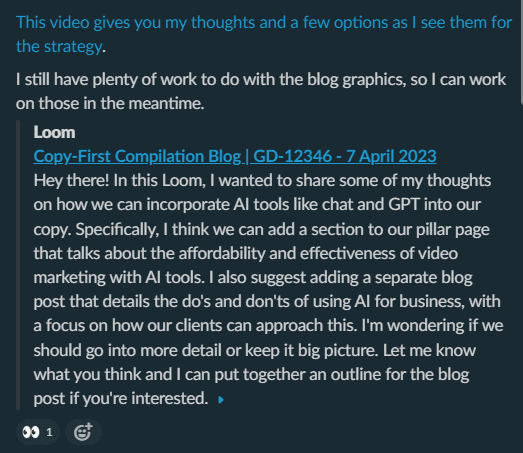
It is more important than ever for small and mid-sized companies to be careful when hiring a copywriter or when using AI themselves.
Ultimately, the copy should always align with your values and brand voice, and any claims made should be fact-checked and documented.
When it comes to video, the bar for good content is more challenging to meet than with copy.
Despite recent gains, video remains inaccessible to some parts of our audience. (Though we are excited to see where the video world takes us in a few more years!)
Where should you focus your marketing efforts right now?
Consider your strengths as a founder, business resources, and how your audience interacts with your brand.
Does a copy-first marketing strategy make the most sense for your company?
Keep reading to learn more.
Below is our comprehensive guide to a sustainable and effective copy-first marketing strategy.
Our goal is to help you determine where to focus your marketing efforts and provide actionable steps for creating a more powerful copy strategy. We’ve also included some video marketing tips for small businesses.
Select a topic to explore below, and be sure to bookmark this page. We have a feeling you’ll want to come back to it again and again.

Why Use a Copy-First Strategy?
The Power of FAQ Pages
Compelling Calls to Action
Writing Your Copy
Formatting Your Copy
Why Use a Copy-First Marketing Strategy?
The #1 reason a copy-first strategy is more powerful than a video marketing focus for small businesses? Words drive almost every connection point with our audiences.
Even video often needs a well-written script or some quality research to make it an effective marketing tool.
And what about your audience who, like me, prefers audio and written materials to videos? (Because there’s nothing like a good podcast to help power through some household chores.)
To truly understand the role words play in marketing, consider the way you interact with brands in the digital space.
- When you’re scrolling through your social media feed, how do you decide what articles or videos to click on? The words in the headlines, descriptions, or video captions that pique your curiosity.
- When you’re scanning a sales page, what ultimately drives your decision to hit “Buy Now?” The words on the page that answer your questions and allay your fears.
- When you’re interacting with a new webpage, what keeps you scrolling and further engaging with the page? The words that continue to provide value for your needs and desires as a consumer.
Businesses use words to get their message, content, and products in front of their customers.
There’s no way around it.
I have very few hard and fast rules for my clients when it comes to digital marketing, and one of them is this:
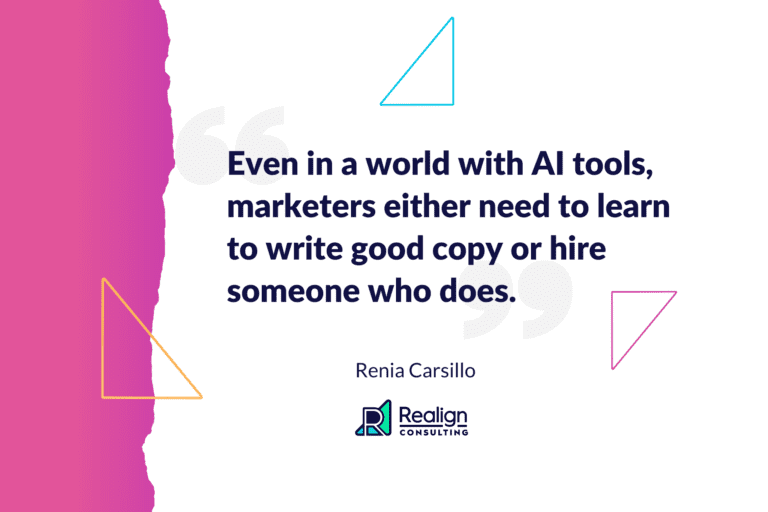
Good copy has three major features:
- It is clear about what customers can expect and who your brand is for,
- It has a people-first perspective that focuses on the needs and wants of the customer, and
- It offers compelling value at every step of the customer journey to attract and retain customers.
For small and micro brands, in particular, copy often forms the core of a sustainable and affordable marketing strategy. It can inform the design and drive user experience—which leads to the next reason why a copy-first approach is so powerful in this digital age.
The second reason small businesses should focus on copy over video is that bad copy undermines even the best-made designs.
Spend just a few minutes on Amazon, and it’s clear that even ugly things sell.
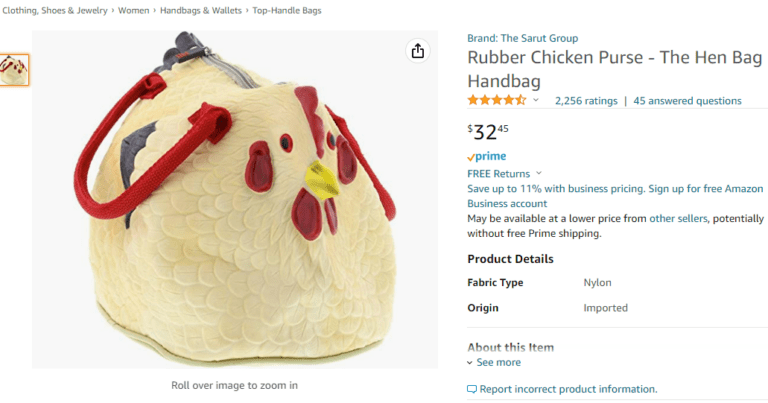
Why? Because the copy is there to convince people they need what’s being sold. (And perhaps people need chicken purses for reasons this article does not have the scope to go into.)
But the opposite is not true. When it comes to making a sale, ineffective copy can spoil even the most fantastic design (or video).
Copy does not have to be complicated to be effective. It just has to do its job. What does that look like?
Ineffective/Bad Copy...
Effective/Good Copy...
- Explains the features instead of the benefits
- Does not address pain points
- Is uninteresting or too difficult to read
- Has too many “asks” (or none at all)
- Focuses on the seller and what they’ve done
- Explains the unique value the product or service offers
- Acknowledges the audience's and specifically addresses it
- Is engaging and easy to read
- Has a clear call to action for each page, ad, or post
- Focuses on the potential buyer and their needs, frustrations, and questions
Ineffective/Bad Copy...
- Explains the features instead of the benefits
- Does not address pain points
- Is uninteresting or too difficult to read
- Has too many “asks” (or none at all)
- Focuses on the seller and what they’ve done
Effective/Good Copy...
- Explains the unique value the product or service offers
- Acknowledges the audience's and specifically addresses it
- Is engaging and easy to read
- Has a clear call to action for each page, ad, or post
- Focuses on the potential buyer and their needs, frustrations, and questions
You may know your target audience and how your product or service would benefit them.
And you may have a beautiful website that is technically sound.
But if you’re struggling to get your audience from the point of awareness to the point of sale, your copy may not be doing its job.
The power of good copy is that it doesn’t just guide your audience along the customer journey. Used correctly, it also convinces search engine algorithms to introduce your brand to customers who have never even heard of you.
This leads us to the third reason why a copy-first strategy should be the focus of most small and micro businesses.
The third reason a copy-first marketing strategy works is effective search engine marketing relies on the right words in the right places—even in your videos.
Search engine algorithms work by looking for content that best matches what people are looking for.
And how do the bots know what content to put in front of consumers?
By crawling the words each brand has put into the digital space.
True, some recent advancements have been in AI bots’ capability to “read” images. But as of 2023, these bots cannot always tell what an image is in context.
Good copy anchors your images, videos, and design to help boost your rankings.

Once again, consider the way that you interact with the digital space.
When you type a question into Google (or do a voice search), the algorithm finds results from brands whose copy is written in a way that lets bots know their content is relevant.
Does your copy take SEO into account?
Is it written conversationally, the way people naturally search for answers?
Have you incorporated the most likely keywords into your titles and headlines, product descriptions, image captions, and bios?
There are many ways to approach marketing. And it is essential to consider how your audience consumes content.
But when it comes to search engine marketing, good copy still provides the backdrop for the rest of your strategy.
Below are some specific steps you can take to get the most from your copy strategy—whether it’s your primary focus or just plays a supporting role.
Provide Value with Well-Planned FAQ Pages
One place a copy-first focus can give you the quickest results is an FAQ page optimized for your audience.
FAQ pages can be a powerful tool for modern SEO when they are done right.
When you take the time to match your copy to the questions your audience is asking, you…
- Help potential customers get the answers they need, and
- Rank higher in search results, making you visible to more customers.
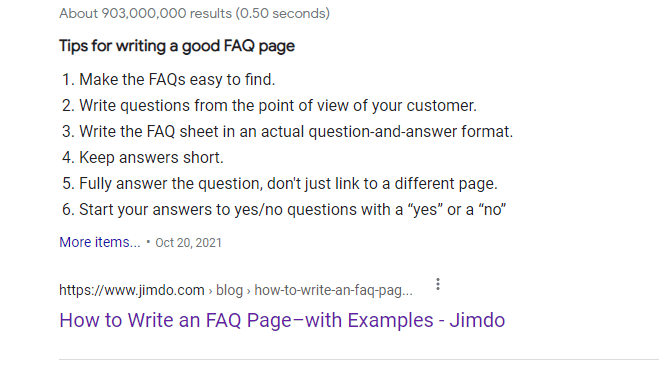
We’ve all been there.
We’re ready to invest in a service or product, but we need to know some specifics first. So we check out the websites of the two or three companies we’re considering.
- One website has an FAQ page that answers general questions about the company, but it doesn’t have the specifics we’re looking for.
- One website doesn’t have an FAQ page at all.
- But just like Goldilocks, we find the third company to be just right. It has an FAQ page specifically focused on the service we’re looking for, and the company seems to have read our minds about our questions and concerns.
Guess who gets our business?
The most powerful FAQ pages answer the questions customers are already searching for, creating higher-quality leads and increasing sales.
I learned the lesson of how powerful an FAQ page could be years ago at the beginning of running my own agency.
One of the first websites we ever worked on was with our client, Mrs. Grout, and part of that project was to create an FAQ page.
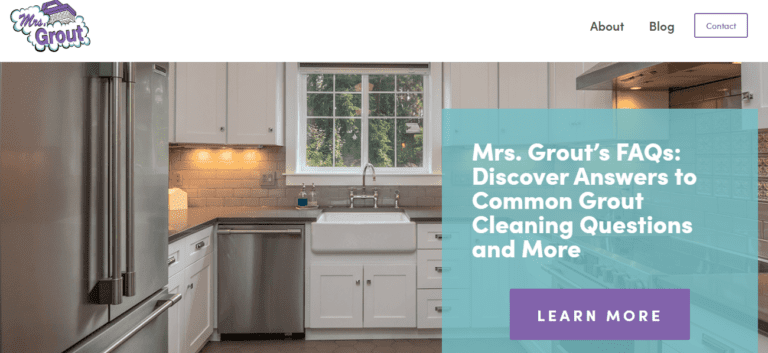
This page accounts for about 25% of Mrs. Grout’s monthly leads — four years after the page’s initial creation.
We’ve spent a little time optimizing the page over the years, but for the most part, the content remains the same.
The best part is, developing an effective FAQ page doesn’t have to be complicated.
Successful FAQ pages center on just two criteria:
- Each FAQ page should focus on only one product or service.
Do you provide multiple services? Create multiple FAQ pages. You will reduce confusion and help your audience find exactly what they’re looking for. - The questions included on the page should reflect the questions people are actually asking.
Your sales team and customer service people are asked these questions daily. And these questions show up most commonly in search when people are looking for what you have to offer.
Leveraging your team experience will create the most successful FAQ page for your company.
To create the Mrs. Grout FAQ page, we asked the company’s sales teams and office team to spend a few weeks documenting the most common questions they were asked.
Since this client provides just one service, we consolidated those questions into one easy-to-read FAQ page.
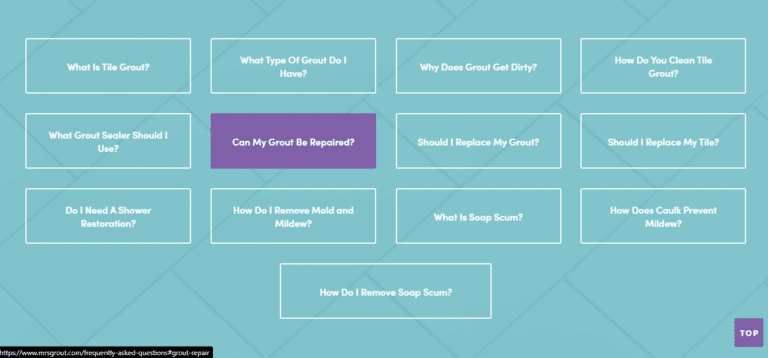
Four years later, this simple page is their website’s third highest-performing page and has brought in hundreds of thousands of dollars for their business.
While the data Mrs. Grout’s team collected told us which topics to cover, we didn’t stop there. We also used the language of Mrs. Grout’s customers to ensure we were asking the questions the same way their audience was asking them.
Why?
Because people search in questions.
And when you match the language of your copy to the language of your audience, magic happens.
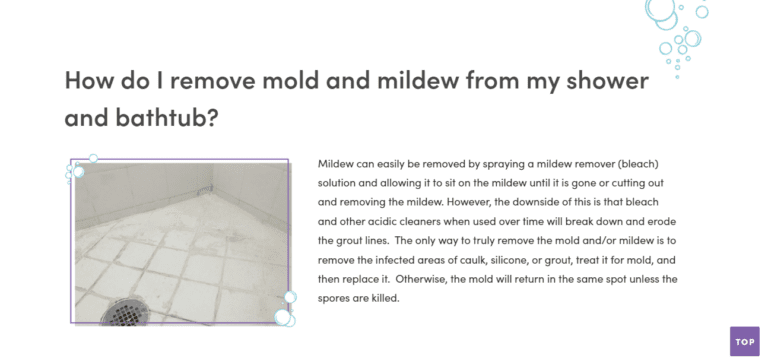
FAQ pages are the perfect place to incorporate medium-tail, action-based keywords and boost your brand’s SEO.
Question-oriented phrases help make it easy for bots to know when your content is relevant to a user’s question.
Using the right keywords helps ensure your content reaches your audience and draws them into everything your brand has to offer. When it seems like everyone is using certain keywords in your industry and creating too much noise, medium-tail keywords help narrow the competition.
But don’t stop there.
It’s not enough to simply create an FAQ page with words and images. To make it more likely that you’ll show up in the questions section of a search, mark up your FAQs with structured data.
Founders and their teams often overlook this part of modern content development. It’s critical to know whether or not your website has this feature built-in, has a plugin for it, or if that work will need to be done manually.
You know those “people also ask” sections on a Google search results page?
Have you noticed that this section is written in question format?
That’s the power of FAQ markup on your page.
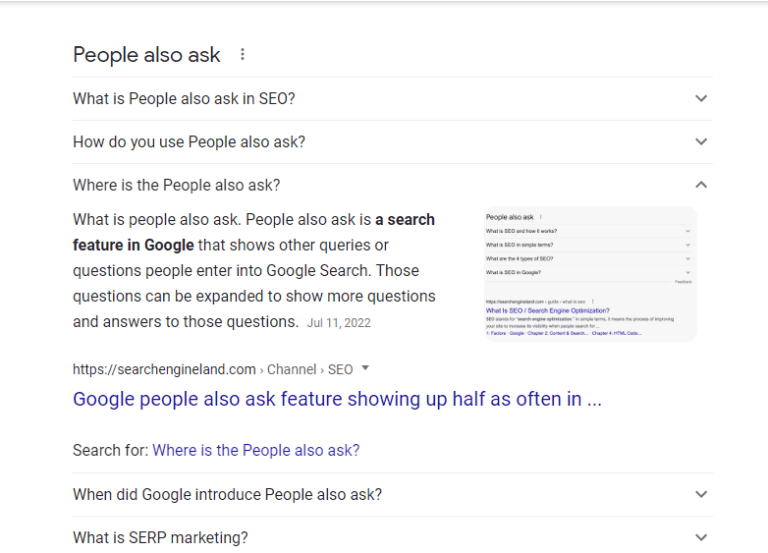
A highly contextual, informationally relevant, and technically sound FAQ page provides some of the highest value for e-commerce, service, and community-based small business websites.
For small businesses considering video marketing, the FAQ page can be a great place to start.
Sometimes it’s more effective to show than to tell. If a question would be easier to answer with some visuals, it might be a great place to add a video.
Just remember that bots still crawl videos for SEO purposes. And they do this by looking at the words you use.
Best practices for SEO in video include…
- Writing a clear title that includes the target keyword. (WHY would your audience want to watch it?)
- Writing an interest-driven, compelling description.
- Incorporating your target keyword and your website address in the description.
Besides helping with SEO, FAQ pages do have another advantage:
This is one of those areas where doing the right thing and doing what’s right for your business overlap.
When we focus on meeting our audience’s needs, we are reminded that business is personal. That’s how we Do Better Digital™.
This simple addition to your copy strategy can give you a lasting return on your investment — financially and relationally.
Reportedly, people are conducting about 8.5 billion daily searches on Google alone.
Your audience is looking for information. With a well-thought-out, customer-centered FAQ page, your brand can be the one to provide it.
How is your brand using FAQ pages?
If your FAQ pages aren’t performing well, consider researching the types of questions your audience is actually asking.
And if you don’t have an FAQ page, maybe now is the time to add one to your content strategy.
Get More Clicks with Compelling Calls to Action
A second place where good copy can give you the quickest results is your CTAs - even with video marketing.
CTAs (calls to action) are critical to your marketing strategy.
The purpose of a CTA is to empower your audience to take action to improve their lives. It’s the “Click here to learn more” and “Sign Up Now” that you see on most advertising and sales pages.
And just like the rest of your marketing, CTAs don’t have to be manipulative to be effective.
CTAs perform best when they are clear, action-oriented, accurate, and appropriate.
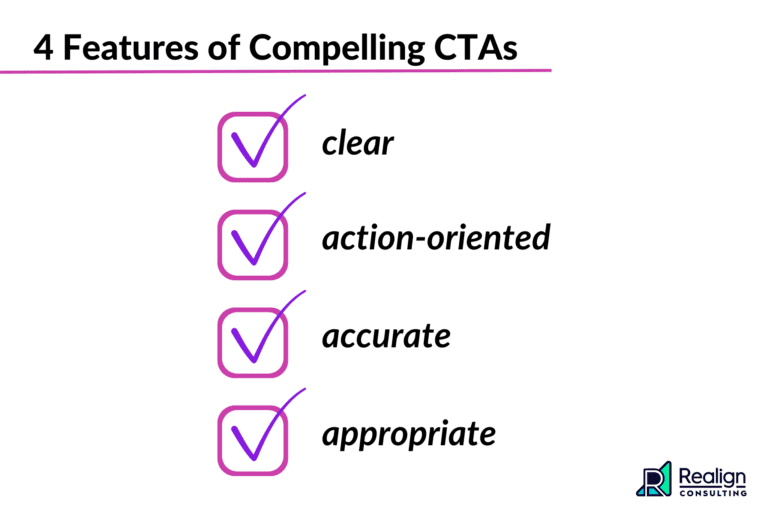
Keep reading to learn more about how to craft effective, values-driven CTAs that will move your audience to action and support sustainable marketing success. No gimmicks required.
The first feature of a compelling CTA is clarity around what you’re offering and how to get it.
The simplest way to avoid manipulation in your marketing is to be clear in your language.
This isn’t the time to get cute or to circle around what you want your audience to do. If the value you offer is really that great, tell your audience about it, and then tell them how to get it.
You can use two different CTA formats to make sure your message is clear, and they both have their place.
The first is the in-line CTA, which tends to perform better. That’s the linked sentence in the middle of your copy, like in the example below.
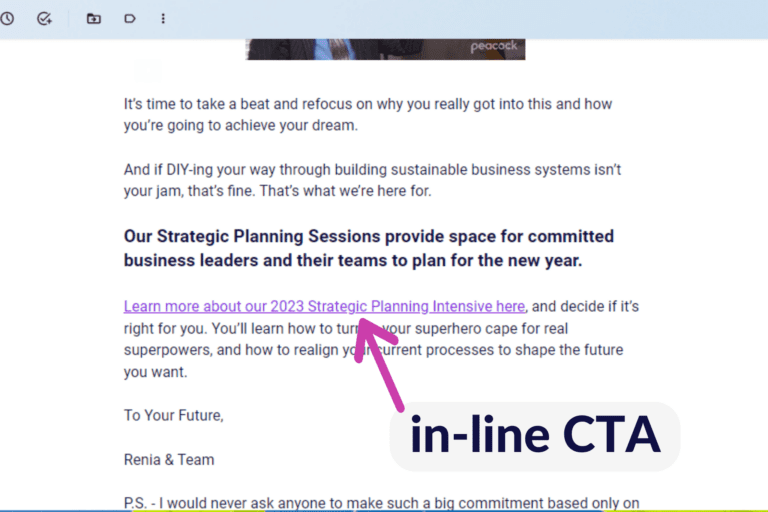
This type of CTA isn’t as “in your face” as the button type I’ll discuss next. It reads more like a friendly offer of information without seeming salesy. At its best, it includes a clear benefit to capture the reader’s curiosity and interest them in discovering more.
One quick tip for using in-line CTAs: for SEO purposes, link more than the “click here” part of the sentence so that bots know the topic value the link offers.
The second type of CTA is the one we’re most familiar with—and most wary of.
Graphic CTAs, which typically include a “button” of some sort, have a history of being used in manipulative ways.
Used correctly, however, they can still work to guide your audience to take the action you want them to take.
This is where being clear and straightforward in your language (and graphics) can play in your favor. Anything flashy or showy could be a red flag to your audience that something isn’t right.
A simple “click here,” “buy now,” or “learn more” is often all the text you really need for a button CTA.
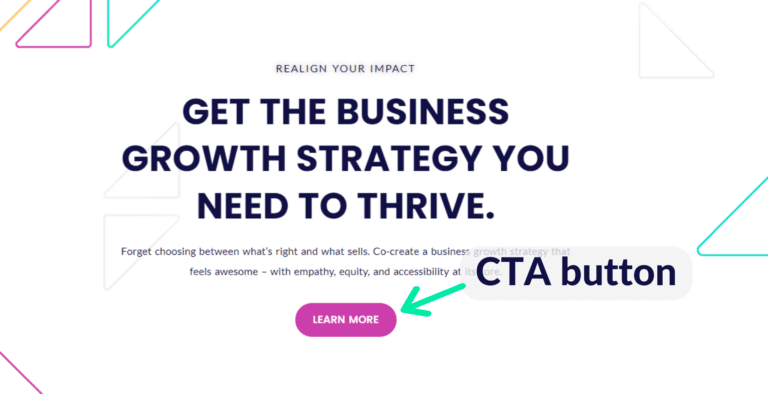
One major benefit of video marketing for small businesses is that videos can organically direct traffic to your website. Just be sure to include a link in your video description so your audience can find you.
The second feature of compelling CTAs is that they are action-oriented.
Your audience doesn’t know what to do until you tell them. Do not force people to guess! Even when you think the action is obvious, state what you’re asking the user to do.
- Do they need to enter their email address?
- Should they call a specific number?
- Or do they need to select your Instagram profile and click “follow?”
It can feel like a herculean task to get your audience to take the action you want them to take. It’s a fundamental law of physics that an object at rest will stay at rest—unless it’s given a little motivation.
While the rest of your copy should give your audience reason to desire what you’re offering, your CTA is that final push to get the ball rolling.
Go here.
Join us.
Save now.
Learn the secret.
It’s called a “Call to Action” for a reason. Remember to be clear on what that action should be.
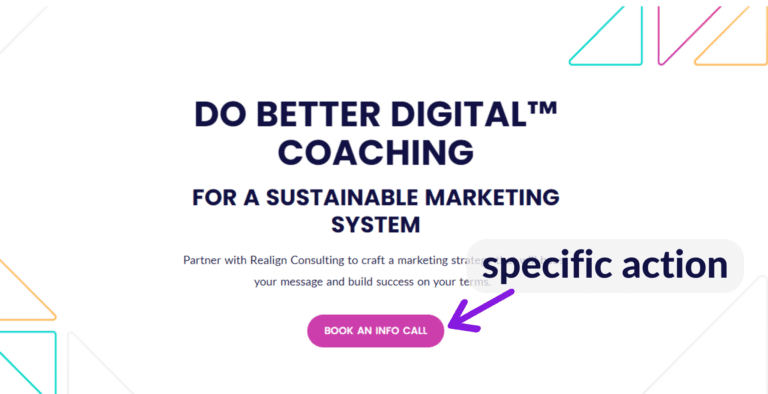
The third feature of a compelling CTA is one with language that matches the landing page it’s linked to.
Perhaps the biggest mistake I see with CTAs is a landing page that doesn’t fulfill the promise of the CTA.
When your audience clicks on “Learn More,” they expect to be led to a page about the specific topic they want to learn more about. And they’re only going to give you a few seconds to make good on that promise before clicking away.
It’s typically not a good sign if your potential customer hesitates in the middle of their buyer’s journey. And a disconnect between a CTA and a landing page can cause them to hesitate.
The best way to ensure your CTA is accurate and effective is to match the language of the CTA to the headline of your landing page.
- “Call an experienced electrician today” is a Click-to-Call button.
- “Learn more about the spring retreat” links to “Spring Retreat 2023 — Everything You Need to Know.”
- “Buy now” actually adds the item to the cart. It does not land on another page that has yet another buy request.
Eliminate confusion in the middle of a potential transaction by ensuring your landing page accurately reflects your CTA.
This rule of thumb works with video marketing as well. Any graphics or language you can take from the video, title, or description and use on the landing page will help smooth the way for your customer.
The fourth and final feature of a compelling CTA is that it is appropriate to where your audience is in their buyer’s journey.
As you develop your marketing strategy, a driving question should always be, “Have I earned the right to make this request?”
A prospective customer who has just now heard of your brand is likely not ready to drop thousands of dollars on a coaching package. They are probably not even prepared to spend a hundred dollars on a smaller product.
You need to earn their trust and prove your value, so a simple request like “follow me on Instagram” or “join our email list” can be a great place to start.
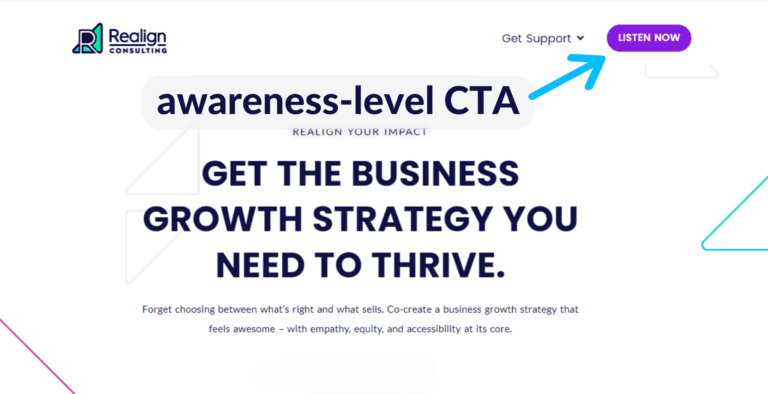
It’s much easier to get the ball rolling with a small request than a large one. And once you’ve established momentum, you can make gradually larger asks.
When deciding what action you want your audience to take, first determine the stage they are in.
- Are they just discovering you or their problem? Offer an easy — and often free — way to learn more.
- Are they fully aware of their problem and are considering options for a solution? Offer more in-depth information or even a small purchase.
- Are they ready to buy? Make sure your CTA is clear on exactly how to make the purchase.
- Are they enjoying that post-decision high? What can you offer to cultivate a raving fan who is excited to tell others about you?
If you choose to use video marketing in your small business, make sure that your video—and the “ask”—make sense for where the viewer is in their journey.
Reasonable CTAs tend to be the most effective CTAs—especially when they are clear, accurate, and action-oriented.*
No manipulation required.
*A NOTE ABOUT AI for CTAs:
This is an area where AI tools like ChatGPT can be helpful. When you have the resources, use A/B testing to determine which CTAs resonate best with your audience.
AI can save you and your team time in this process. Rather than coming up with alternative CTAs yourself, have AI generate them for you.
Which ones you choose to test should be determined by the four features of compelling CTAs outlined above. But AI can get you to the point of testing faster.
What CTAs could you rework right now?
Or, if you’ve avoided them, where could you add CTAs along your buyer’s journey?
What changes can you make to help spur your audience to take action to improve their lives?
Now that you have two specific areas where good copy can make an immediate impact, let’s discuss how to improve the copy in all areas of your marketing.
Write Copy That Moves Your Audience to Action
Below are five essential tips for writing manipulation-free copy that puts your audience first.
One of the biggest barriers I come up against when I start working with a new client is their aversion to coming across as a stereotypical salesperson to their community.
And I get it.
We’ve all been burned by underhanded marketing tactics and don’t want to do the same to the people we’re trying to serve.
But just because marketing can be manipulative doesn’t mean it has to be.
For impact-driven founders, manipulation-free marketing is one of the foundations of a sustainable business.
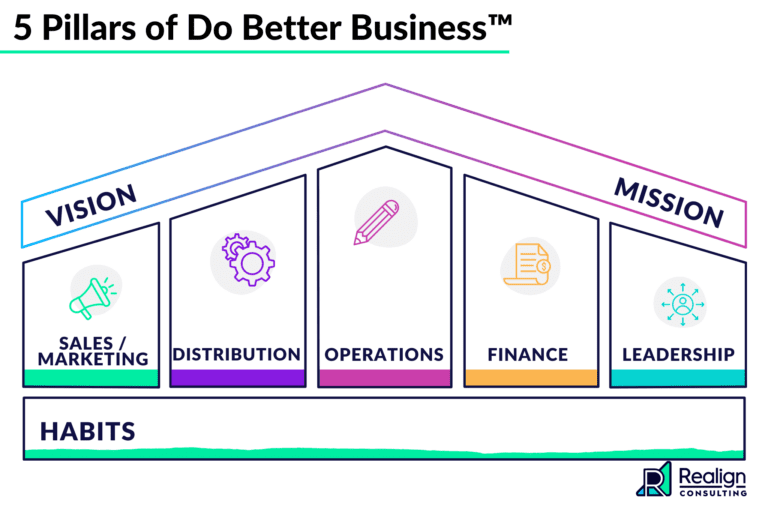
One of the keys to avoiding manipulation in your marketing is to use clear, honest copy that answers this question for your audience:
How can you help them get to where they want to be?
Even if you are using video marketing in your small business, your approach to copy is essential to your marketing success.
Whether you’ve hired a copywriter, are writing the copy yourself, or using a combination of the two, these five tips are essential to crafting compelling, manipulation-free copy.
Tip #1: Write for the internet, not your high school classroom.
Clear, straightforward copy is one of the easiest ways to avoid manipulation in marketing.
When it comes to online content, most people do not read word-for-word. Most of the people reading this article won’t read this entire sentence.
With all there is to consume in the digital space, most of us skim headlines and articles, looking for content that is most relevant to us. (This is why the title of your video is so important.)
So, you have to craft your copy that is easily scannable and clear on its relevance.
This means using…
- Small blocks of text, with paragraphs containing only 1–3 sentences,
- Bullet points or numbered lists,
- Lots of white space, and
- Headlines and bolded lines that guide the reader down the page.
Of course, getting your audience’s attention is just the beginning.
Cute or creative copy may get your audience to pause, but it won’t necessarily get them to take the action you want them to take.
That’s why it’s critical to be upfront and clear about the value your product or service provides your audience.
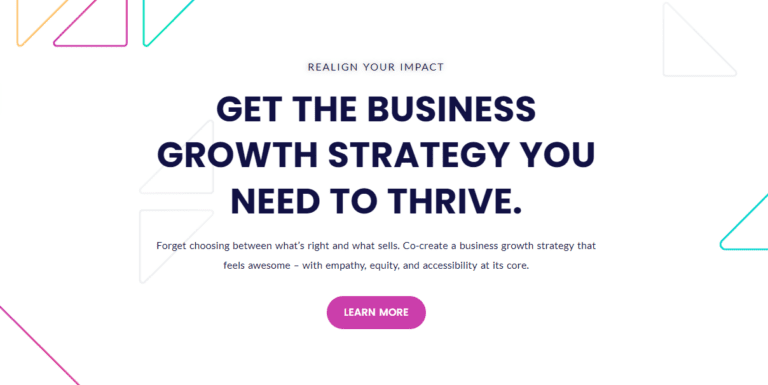
Maybe high school did teach us one thing — always have a thesis statement, or a purpose for writing. Just don’t waste your time getting to the point.
Tip #2: Use accessible language that makes your content easy to consume.
Most Americans read at a 7th or 8th-grade reading level. This could be for several reasons, including a lack of access to education or a disability that affects reading comprehension.
To get your message across to your audience, you must match your language to what they will easily comprehend.
Even for the college or post-graduate crowd, straightforward language means quick comprehension that keeps your audience engaged and moving down the page.
Manipulation-free marketing doesn’t gate-keep or alienate. It treats the customer like a friend with an issue that you’re uniquely qualified to address.
My team uses the Hemingway App, named after the writer famous for his simple, straightforward, and direct writing style.
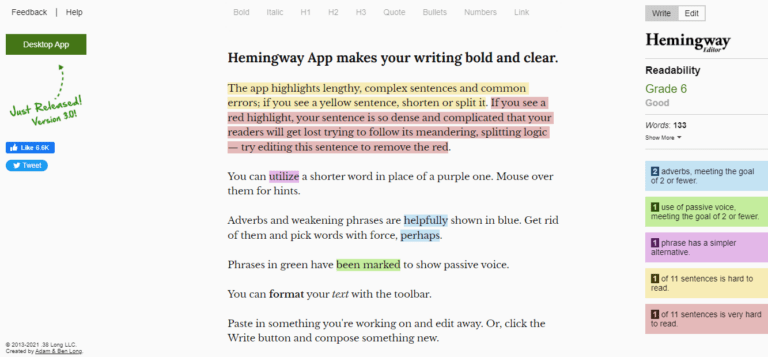
This free app gives your content a readability score based on grade level and suggestions for improving it. And our copywriting checklist includes details about the ideal score depending on the audience.
Tip #3: Write for your audience, not your brand.
What would you say if you could sit down to have coffee — or something stronger — with your ideal customer?
Would you use up air time making a sales pitch?
Or would you listen to their dreams, challenges, and desires before offering specific help?
Copy that moves an audience to action doesn’t stand on a pedestal and announce a brand’s greatness to the world. It acknowledges what a person needs and offers a path to a solution.
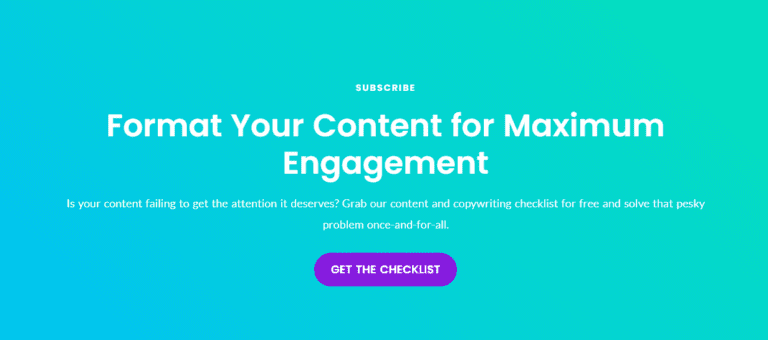
If you want to avoid manipulation in marketing, remember that you’re there to help, not to impress. (And one benefit of video marketing for small businesses is that videos can help you provide more direct value for your customers.)
Tip #4: Use a checklist to make best practices a habit.
The key to creating a sustainable habit is to do the same thing over and over and over again.
But when you’re busy leading your business, you don’t always have time to remember every detail you’ve learned about writing compelling copy.
I’m a big fan of Atul Gawande’s book, The Checklist Manifesto. His work has influenced my team to create and use various checklists to ensure we are consistent with our standards. My coaching clients probably get tired of hearing me repeat one of my favorite mantras:
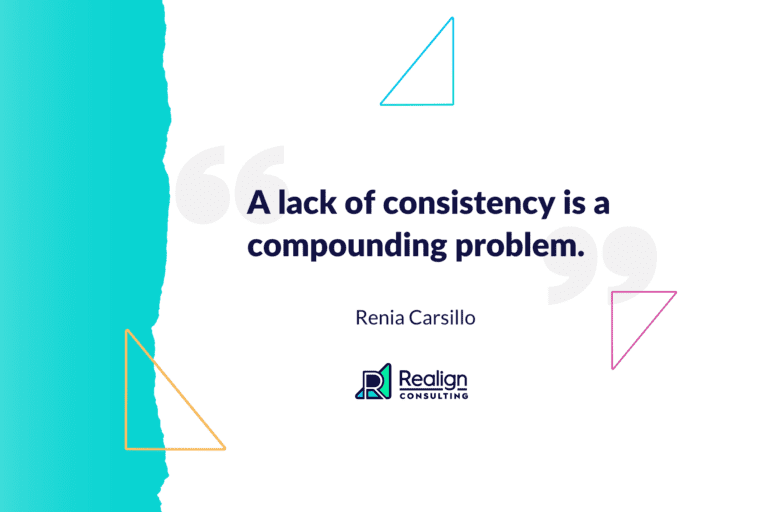
To create consistency, my team uses a checklist to review every piece of copy that we produce
We have found that our copywriting checklist helps us to…
- Be consistent in our brand voice and overall “feel” of our copy,
- Use best practices every time, no matter what, and
- Quickly bring new copywriters up to speed as they adapt to writing for our brand.
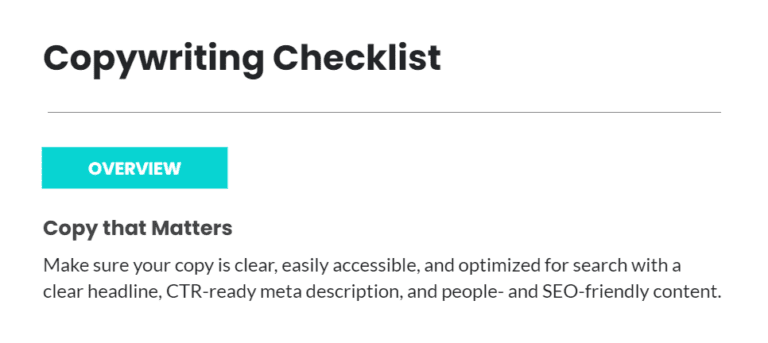
Just like veteran and new pilots alike use a checklist every time they take off, we use a checklist to help our copy soar instead of crash.
Tip #5: Run your copy by a fresh set of eyes every time, even if it’s an AI grammar checker.
We’ve all done it.
We write something amazing about our brand, put it out into the digital world—and realize after it’s published that we’ve misspelled or even completely left out a word.
Of course, a mistake in your copy isn’t the end of the world.
But copy with frequent spelling errors or grammar mistakes can create a couple of issues for your brand.
- Our brains have been trained to see sloppy writing in marketing as a scam. We tend not to trust websites with a lot of grammar and spelling errors. It’s difficult to view the brand as professional and trustworthy — and at its worst, poor writing can just be confusing.
- If a search engine algorithm can’t figure out what your page is about, it won’t rank well in search results. Google isn’t going to dock you for a split infinitive. But excessive grammar and spelling issues could be a problem when it comes to getting your content in front of your audience.
You may overlook little mistakes when you’ve been focused on finding the right words to get your message across. Our brains tend to autocorrect to what we expect to see.
To increase our chances of finding these errors, we use a two-part editing process:
- First, the person who has written the copy runs it through Grammarly. This is another free app that saves valuable time by catching those little mistakes that our exhausted eyes skip right over. It can also give you a fresh perspective on your words that might inspire you to make changes for an even more compelling message.
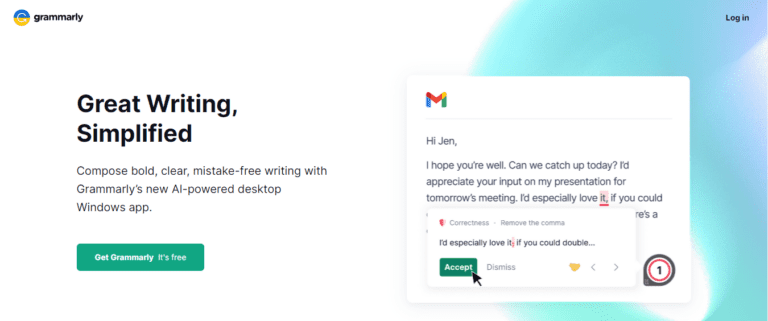
- Second, someone else on our team reviews the copy using our copywriting checklist. We’re all human, and we all make mistakes. Even when a writer knows the checklist backward and forward, they could miss something that a fresher pair of eyes could catch.
Our editing process isn’t about perfection.
It’s about giving our copy* the best chance at success to be clear, compelling, and manipulation-free.
*A NOTE ABOUT USING TEXT-TO-TEXT AI for YOUR COPY:
You can absolutely use text-to-text AI tools like ChatGPT to enhance your marketing and copy strategy. But AI is not a golden goose.
There are a few things to keep in mind when using tools like ChatGPT:
- You get out what you put in. The more refined your marketing prompts for ChatGPT, the more accurate and useful your results will be. Be sure to spend time getting the know the best practices for whichever AI tool you use.
- Security matters. Sharing proprietary or private client information into generative AI is a big security risk. If you’re dealing with sensitive information, it doesn’t belong here.
- Google and other search engines still have the same goal: to provide relevant and useful content. No, you won’t get docked for using AI-generated content. But if your content quality goes down because you did not revise it for relevance, accuracy, and authenticity, don’t be surprised if you don’t rank as high in search.
- Fact-check, fact-check, fact-check. See my note about AI “hallucinations” at the beginning of this article.
- Fact-checking and revising AI-generated content to fit your brand voice is a skill. It requires knowledge of copywriting, marketing, your brand voice, and industry standards and trends—plus that personal touch only a human can provide. If you hire someone to do this for you, they should be fairly compensated.
- The rules for compelling copy still apply. Whether your copy is generated by people, AI, or a little bit of both, it must be clear and easy to understand, focus on the benefits to your audience, and be consistent in brand voice and messaging.
In what specific ways can you use AI tools to boost your copy strategy? Try these ideas:
Generate crappy first drafts.
Every writer has been stumped at some point by their nemesis: the blank page. Use AI to generate a basic draft or outline to get things started. Then, adapt it to your brand voice.
Jumpstart research with specific sources.
As long as the data was available before 2021, there’s a good chance ChatGPT has access to it. Just be sure to prompt it to cite its sources, and then check them for accuracy.
Optimize page or article headlines and email subject lines.
It can be challenging to narrow down your central message to a few words that are compelling enough to get your audience to click for more. Use AI to generate some headlines for inspiration.
Create content with unchanging, impersonal information.
ChatGPT cannot search the web and doesn’t have access to information past 2021. But you can certainly use it to summarize a presentation, list the benefits of a given solution, or suggest common pain points of a particular audience.
As with any tool, the benefits you see with text-to-text AI depend on how well you use it.
Keep reading to learn how to use formatting to enhance all the work you’ve already put into your copy.
Format Your Copy for Maximum Engagement
A copy-first marketing strategy wouldn’t be complete without proper formatting to make your copy shine.
I’m not talking about fancy web design.
As with video marketing, small businesses often find sophisticated, elaborate web design difficult to access. For our clients, we recommend using design to enhance the stories they’re telling with their words. This way, most of their resources go toward optimizing their copy.
And copy is what sells.

Below are the simple DIY formatting tips we use to create compelling content that engages readers and moves them to take action.
Successful digital content includes at least two features— engaging headlines and mobile-friendly formatting.
Let’s start with headlines.
The titles and headings of your content serve three purposes.
- To outline what your content is about for your audience.
- To outline what your content is about for search engines.
- To outline what your content is about for screen readers.
Most people only read the title, headlines, and maybe the first couple sentences of a piece of content before deciding if it is worth their time.
What message is your content sending when you skim it?
Does it explain the value you are offering? A reason to pause and dig deeper?
If the benefit to the readers is unclear in your headlines, your audience may decide to move on.
When it comes to SEO, it’s not enough to use benefit-driven headlines. For better search engine rankings, remember to use header tags.
Search engine algorithms use cues to quickly understand what content best matches a user’s query. One of those cues is header tags.
Fortunately, most website builders make this part easy.
While each drag-and-drop website editor is different, there are some similarities. For our site, we are currently using the Elementor WordPress theme. As you can see below, we simply select the “Heading” block and drag it to the correct place on the page.
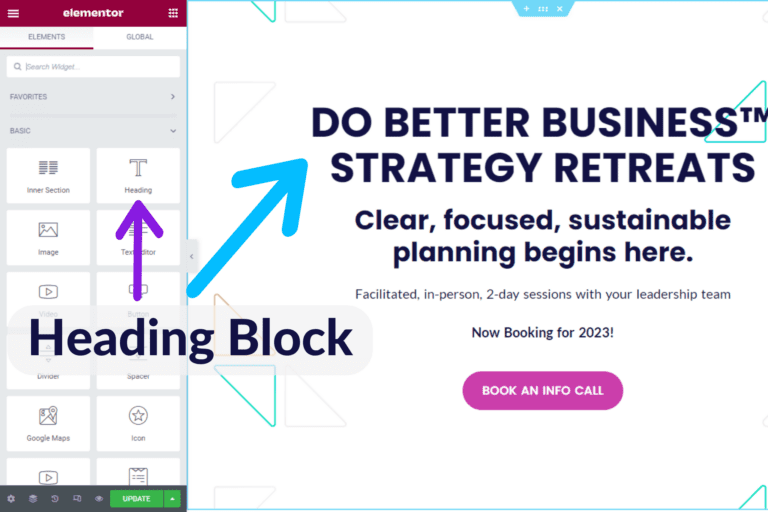
Then, we select which type of header tag we want to use.
Think of the outlines you may have created in school. There should be one—and only one—primary purpose or focus.
In formatting, this is called your Heading 1, or H1.
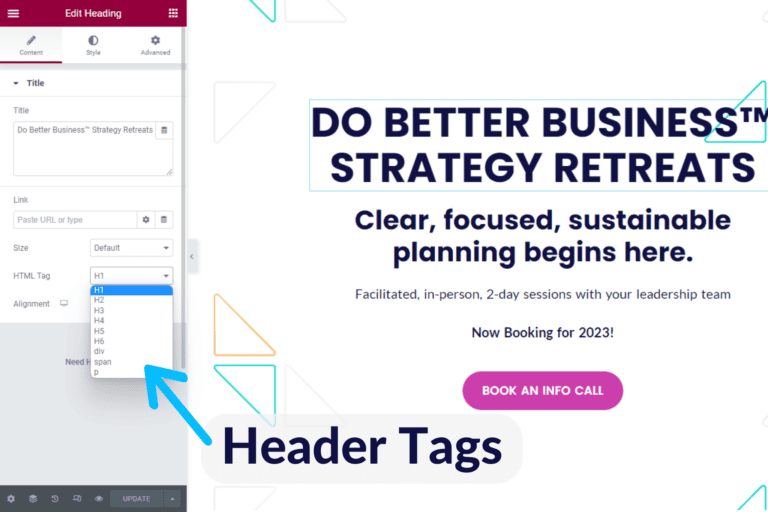
Your main topic is then divided into subtopics (H2s), which are further divided into sub-subtopics (H3s), depending on the content.
When you choose the words of your headlines with purpose and match them with header tags, you eliminate confusion when bots crawl your page.
By taking these steps to make your content more engaging to your audience, you’re also making it more accessible.
Screen-reader users are not exceptions to the rule that most people skim digital content, stopping only when they find something relevant to them.
Using benefit-driven headers and header tags makes it easier for screen-reader users to navigate and engage with your content.
Learn more about why sustainable businesses need accessible digital content.
Once you’ve mastered the properly formatted header, it’s time to focus on mobile-friendly design.
According to one study, almost 60% of web traffic now comes through mobile phones.
However, not all websites are formatted to work well on mobile devices.
Suppose you put out an ad directing your audience to a sales page for your latest service, but the page isn’t optimized for mobile. How many do you think will stick around long enough to find that “Buy Now” button?
According to another study, which puts mobile-based web traffic nearer to 70%, mobile-first formatting significantly impacts sales and engagement:
- 61% of users are turned off by websites that are not formatted for mobile.
- 80% of users are more likely to buy from mobile-friendly apps or sites that are easy to navigate.
- 70% of mobile-based searches lead to online action, like calling, booking, or purchasing.
Fortunately, making your copy mobile-friendly requires only a few simple steps.
The first step to mobile-friendly formatting is to make sure you are using a responsive website builder.
The good news is that, as of 2023, it might be more challenging to find a website builder that hasn’t caught on to the mobile trend. A quick Google search shows Wix to be very popular for mobile responsiveness. Other common choices are WordPress, Squarespace, Weebly, and Shopify.
The next step is to avoid cramming too much into a small space.
This is a good rule of thumb for posting any internet content. Plenty of white space, bulleted or numbered lists, and short paragraphs make our content more engaging and easier to consume.
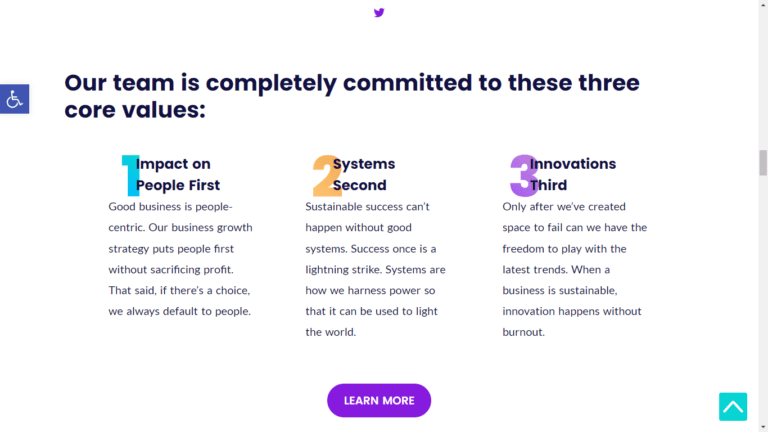
The third step for mobile-friendly formatting is to avoid pop-ups or disable them for mobile users.
When used strategically, pop-up ads on your website can positively impact sales.
But on a mobile device, they tend to be distracting at best. The pop-up could cost you customers if a user cannot easily click away.
When my clients want to use pop-ups on their sites, I encourage them to disable them for mobile — a common feature in most website builders.
The final and possibly most crucial step to mobile-friendliness is to test, test, test.
Before any of our content goes live, for ourselves or our clients, we check it on a mobile device.
- Is the font large enough?
- Do any images show up strangely?
- Does each link work?
It won’t work for our audience if it doesn’t work for us.
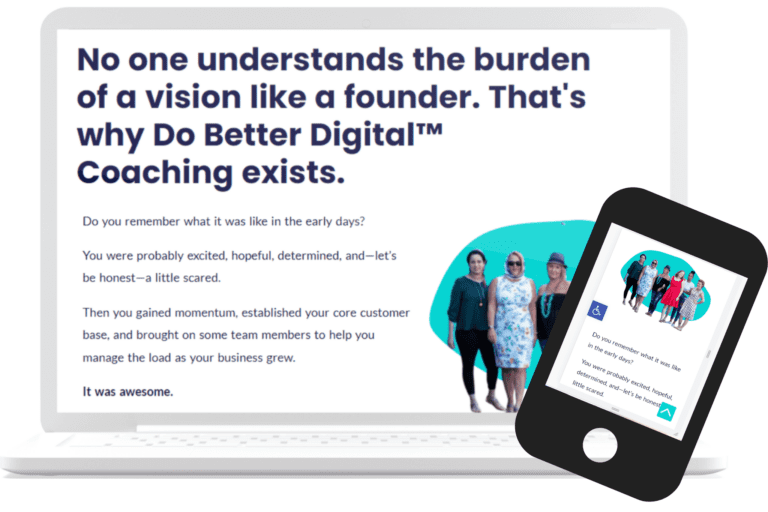
Good design helps enhance the story we are telling with our words. And it doesn’t have to be complex to be effective.
For most local businesses, a copy-first digital strategy will be more sustainably cost-effective than one focused primarily on fancy web design or video marketing.
These simple DIY formatting tips can make your copy shine even when resources are limited. And with compelling copy to boost engagement and sales, who knows what your resources will help you do next? (Maybe add a few videos to your site?)
Which of these formatting tips can you implement right now?
Do the headings on your homepage tell your audience what they need to know about your business?
Do your emails read well on mobile?
What steps can you take to make your content more engaging and effective?
By the way, our free copywriting checklist includes formatting tips and reminders. Get it here!
Are the benefits of video marketing worth the cost of production for your small business right now?
Only you can answer that question.
Just remember that a copy-first focus can enhance every marketing strategy.
The words we use to reach our customers matter, whether they are written or spoken, in a video description or a sales page.
Our words guide our audience to our products and services, explain their benefits, and show them how they can take action.

Before deciding whether to use video marketing for your small business, focus on optimizing your copy first.
You might find your answer along the way.
Do you want more personalized guidance to implement a copy-first strategy for your brand?

Learn more about our Do Better Business™ Coaching Program.
You’ll work one-on-one with our Chief Strategist, Renia Carsillo, to develop sustainable marketing strategies and systems tailor-made for your business.
We don’t have to choose between what’s right and what’s right for our businesses. Check out Do Better Business™ Coaching today!

